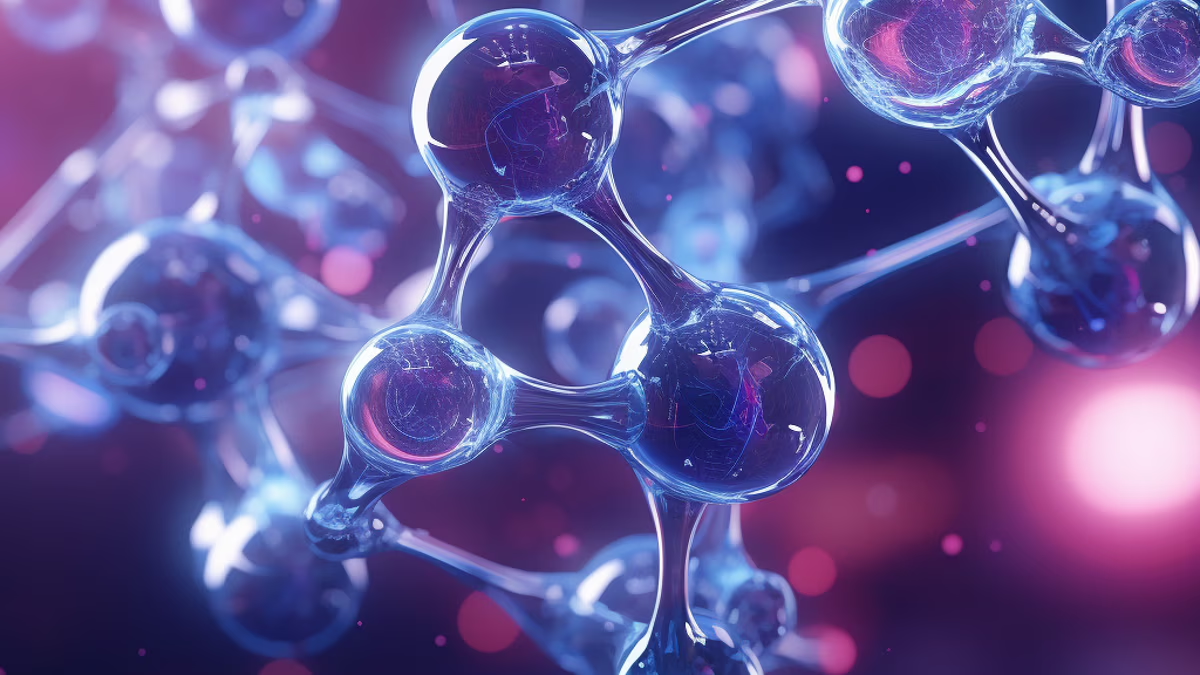
The conducted study evaluated the molecular-cellular impact, effect on biological age and aging markers, and the clinical efficacy of the peptide IPH PRO as a protector of urological health. All patients were examined before surgery according to the standards of providing urological care to the population (Order of the Ministry of Health of Russia from 12.11.2012 No. 907n). Additionally, using the immunoluminometric analysis method on the “Beckman Coulter” analyzer with original “Hybritech Tandem™-R” calibrators, the levels of total PSA (tPSA) and free PSA (fPSA) in blood plasma, p2PSA, [-2]proPSA were determined, their percentage ratio to total PSA was calculated, as well as the density of tPSA and fPSA (the ratio of the corresponding PSA fraction to the volume of the prostate gland).
The Prostate Health Index (phi) was calculated using the formula: To assess depressive disorders, the Beck Depression Inventory was chosen. The SF-36 questionnaire was used to evaluate quality of life.
We used German peptides IPH PRO, which have all permits and approvals for the world markets, such as: WADA certificate (anti-doping), MAFFA certificate (safety), ORGANIC certificate, HALAL certificate, patent protection: a patent in the United States – Patent Application Publication (United States, No.:US2021/052534A1, date: Feb.25,2021), patent in the European Union No. 016704471, patent in the Russian Federation No. 645608, patent in the People’s Republic of China No. 30507522.
Effectiveness of using the peptide IPH PRO over a year. In processing the study data, the calculation of mean intensive and extensive values was carried out with the calculation of the standard error; the significance of differences between two groups was assessed using the Student’s t-test (the difference in indicators was considered significant at t>2, p<0.05).
Protective properties of the peptide IPH PRO at the gene-molecular level. The formation of a healthy pool for the functioning of the male genitourinary system begins as early as the embryogenesis stages. Therefore, drugs that show positive results on the formation of proper embryogenesis of the male genitourinary system are a priority and have oncoprotective properties. Disruption in the genetic apparatus makes a person susceptible to rapid and early diseases of the genitourinary system. Therefore, it is important to determine the possibility of the peptide IPH PRO’s impact on the genetic apparatus in terms of cytostatic preservation. To evaluate the cytostatic and oncoprotective properties of the peptide IPH PRO regarding the male genitourinary system, embryonic stem cells were chosen.
Optimal functioning and adjustment of Val89Leu (V89L), STR TAAAA(n), STR (CAG)n gene polymorphisms lead to the proper functioning of the male genitourinary system. The cytoprotective abilities of the peptide IPH PRO were studied through the expression of Val89Leu (V89L), STR TAAAA(n), STR (CAG)n gene polymorphisms (Figure 1).
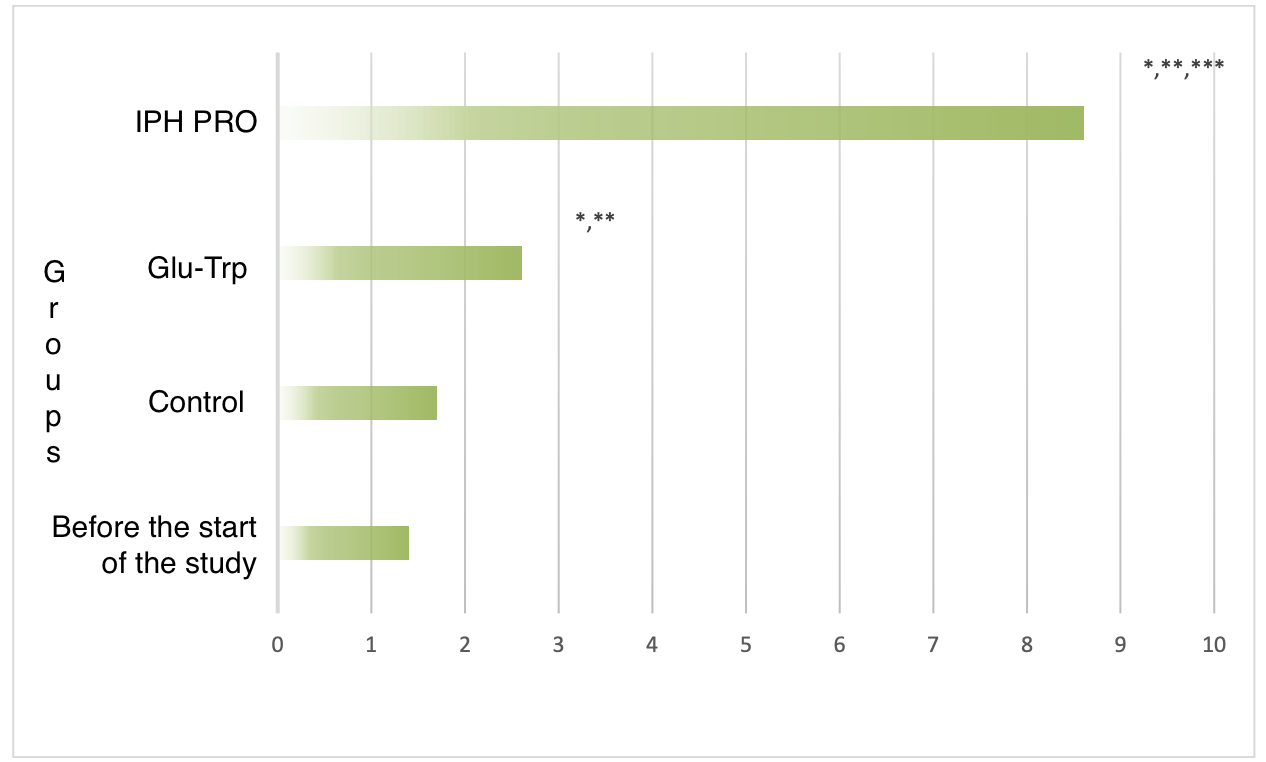
*p<0.05 compared to baseline data;
**p<0.05 compared to control;
***p<0.05 between the expression levels when using Glu-Trp and IPH PRO.
Figure 1. Expression of Val89Leu (V89L), STR TAAAA(n), STR (CAG)n gene polymorphisms.
An improvement in the expression of Val89Leu (V89L), STR TAAAA(n), STR (CAG)n gene polymorphisms was determined to be 67.8% when using the peptide IPH PRO. Such results demonstrate oncoprotective and cytostatic properties.
These experimental data allowed us to determine changes in laboratory data, which are significantly altered in the presence of benign prostatic hyperplasia.
The use of the peptide IPH PRO leads to a 1.5-fold decrease in tPSA levels (χ2=6.357 p=0.011), a 1.14-fold decrease in %fPSA (χ2=9.403 p=0.002); a 1.10-fold decrease in [-2]proPSA levels (χ2=26.650 p=0.0001); a 3.34-fold increase in %[-2]proPSA (χ2=90.704 p=0.0001) (Table 1).
Table 1: Overview of the laboratory parameters of patients depending on the use of the peptide IPH PRO
| Indicator | Control Group (N=22) | Peptide IPH PRO Application |
|---|---|---|
| Age, years | 50.6±6.7 <br> Median [IQR]: 49.5 [46.0-56.0] | 53.6±7.1 <br> Median [IQR]: 53 [49.0-59.0] |
| tPSA, ng/ml | 5.9±1.5 <br> Median [IQR]: 5.6 [4.4-7.4] | 5.0±1.5 <br> Median [IQR]: 4.9 [3.9-6.3] |
| fPSA, ng/ml | 0.584±0.290 <br> Median [IQR]: 0.580 [0.330-0.850] | 0.679±0.368 <br> Median [IQR]: 0.600 [0.410-0.850] |
| %fPSA, % | 9.8±4.3 <br> Median [IQR]: 10.4 [6.2-13.2] | 13.7±6.4 <br> Median [IQR]: 12.6 [8.8-16.8] |
| [-2]proPSA, pg/ml | 31.1±15.9 <br> Median [IQR]: 30.2 [23.4-42.2] | 15.9±9.4 <br> Median [IQR]: 14.0 [10.2-19.2] |
| %[-2]proPSA, % | 5.49±1.50 <br> Median [IQR]: 5.32 [4.67-5.87] | 2.45±0.90 <br> Median [IQR]: 2.37 [1.89-2.98] |
| Prostate Health Index | 27.5±2.9 <br> Median [IQR]: 23.0 [19.0±24.2] | 14.8±1.5 <br> Median [IQR]: 19.1 [10.8-25.5] |
| Prostate Volume, cm³ | 54.7±20.9 <br> Median [IQR]: 54.5 [41.0-75.0] | 45.4±18.9 <br> Median [IQR]: 40.0 [31.0-55.0] |
| Maximum mSS, score | 4.66±0.57 <br> Median [IQR]: 5.0 [4.0-5.0] | 3.34±0.92 <br> Median [IQR]: 3.0 [3.0-4.0] |
| S/D | 5.19±0.41 <br> Median [IQR]: 5.26 [4.80-5.55] | 5.17±0.37 <br> Median [IQR]: 5.18 [4.85-5.50] |
| MnV | 8.14±1.44 <br> Median [IQR]: 8.72 [6.59-9.20] | 8.03±1.31 <br> Median [IQR]: 8.15 [6.98-9.12] |
| PVS | 13.6±1.7 <br> Median [IQR]: 16.6 [11.8-14.9] | 13.5±1.5 <br> Median [IQR]: 13.4 [12.1-14.8] |
In patients who used the peptide IPH PRO, the Prostate Health Index was close to 14.8±19.5%, which is associated with a low risk of developing malignant oncological diseases.
A reduction in prostate volume was noted after the application of the peptide IPH PRO by 24.6%, indicating properties that normalize the function of the prostate gland in patients with BPH (Figure 2).

A – before the application of the peptide IPH PRO
B – after the application of the peptide IPH PRO
Figure 2. Dynamics of prostate volume over the year (before and after the application of the peptide IPH PRO).
The use of the peptide IPH PRO leads to an improvement in the urological health of patients with BPH. This was reflected in the improvement of the maximum urinary flow rate by 1.7 times over a year of observation (Figure 3).

Figure 3. Dynamics of the maximum urinary flow rate over a year after the application of the peptide IPH PRO and without it.
As a prognostically unfavorable parameter, we analyzed the median urine retention in our patients over the year (Figure 4).
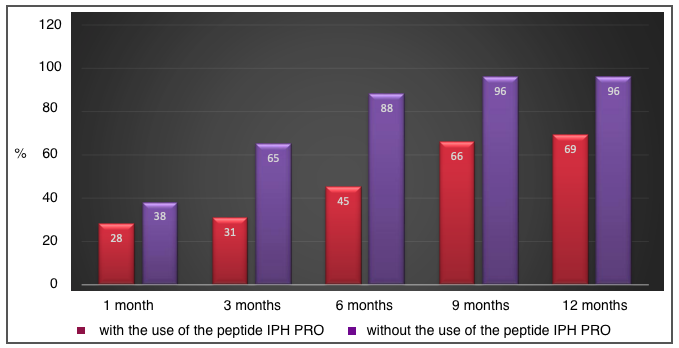
Figure 4. Dynamics of urine retention in our patients over the year after the application of the peptide IPH PRO and without it
It should be noted that the most rapid dynamics of urine retention were observed after the application of the peptide IPH PRO already within 3 months, which resulted in an improvement of the indicator by 57.8%. This significantly improved the quality of life of our patients, both in psychological and physical components of health, as urinary incontinence reduces the quality of life according to statistics in 78.8% of patients with BPH. Long-term results of the application of the peptide IPH PRO are better compared to short-term intake.
In oncological urology practice, calculators are widely used to calculate the risks of developing malignant urological diseases. We used the simplest third-level calculator in two modifications to study our patients with BPH: without the application of the peptide IPH PRO and with the consideration of the application of the peptide IPH PRO (Figure 5).
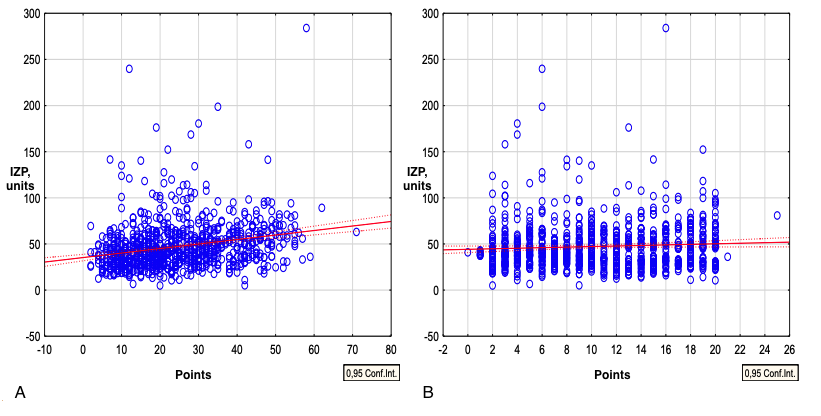
A – without the application of the peptide IPH PRO
B – with the application of the peptide IPH PRO
Figure 5. The relationship between the Prostate Health Index and the risk of developing malignant urological diseases
When using the first and second parts of the third-level calculator, the relationship with the Prostate Health Index value was directly proportional with the application of the peptide IPH PRO. The proportional distribution of the Prostate Health Index after the application of the peptide IPH PRO indicates high practical oncoprotection and improvement of urological health quality.
Such an improvement in urological health led to a reduction in depressive disorders from severe and moderate disorders to mild, i.e., from 24.6 points to 11.4 points. Whereas in patients without the application of the peptide IPH PRO, moderate and severe depressive disorders remained (Figure 6).
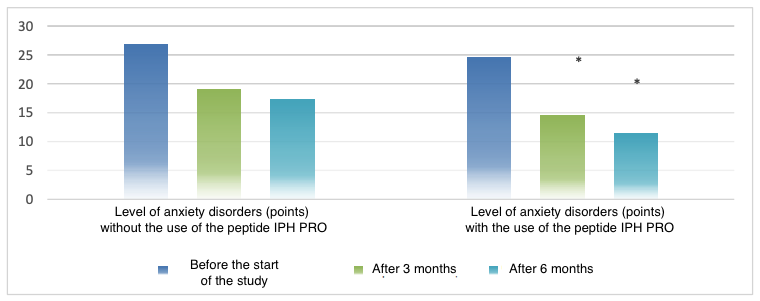
*p<0.05 between indicators compared to the indicators before the start of the study.
Figure 6. Level of anxiety disorders (scores, M±m).
The obtained data confirm the fact that the application of the peptide IPH PRO contributes to a reduction in the level of depressive disorders by 47.2%, confirming its clinical efficacy regarding the genitourinary system.
Further, an assessment of the psychological and physical components of quality of life and the influence of the application of the peptide IPH PRO on the functionality of the organism was conducted.
Before the start of the study, attention is drawn to the low indicators of physical and emotional health components, which reduces the physical component of health (Figure 7).

Figure 7. Dynamics of physical and psychological components of quality of life (scores, M±m)
However, the subsequently obtained data confirm the fact that the application of the peptide IPH PRO contributes to an improvement in the quality of life by 49.1% from the physical component, confirming the fact that the peptide IPH PRO acts as a protector of the genitourinary system function in men, thus improving the quality of life.
1. Ilnickii A.N., Prashchayeu K.I. Neujazvimye. Kniga o zdorov’e [Invulnerable. The book about health]. M.: Diskurs [Discourse]; 2021. 336 p.
2. Devlin CM, et al. Benign prostatic hyperplasia – what do we know? BJU Int. 2021; 67: 328-333.
3. Kim EH, et al. Management of Benign Prostatic Hyperplasia. Annu Rev Med. 2016; 34: 263-319.
4. Aaron L, et al. Review of Prostate Anatomy and Embryology and the Etiology of Benign Prostatic Hyperplasia. Urol Clin North Am. 2016; 16 : 274-276.
5. Mobley D, et al. Benign prostatic hyperplasia and urinary symptoms: Evaluation and treatment. Postgrad Med. 2015; 258: 23-64.
6. Havinson V.H., Lin’kova N.S., Kvetnoj I.M. et al. Molekuljarno-kletochnye mehanizmy peptidnoj reguljacii sinteza melatonina v kul’ture pinelocitov [Molecular and cellular mechanisms of peptide regulation of melatonin synthesis in pinealocyte culture]. Byulleten’ eksperimental’noj biologii i mediciny [Bulletin of Experimental Biology and Medicine]. 2012; 153 (2):223–226.
7. Trofimova S.V., Lin’kova S.N., Klimenko A.A. et al. Pineamin povyshaet sintez melatonina v jepifize u lic pozhilogo vozrasta [Pineamin increased pineal melatonin synthesis in elderly people]. Uspehi gerontolii [Advances in Gerontology]. 2017; 30(3):422–426.